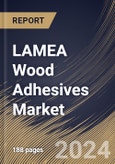Luxury vehicles often feature wooden veneers on dashboards, door panels, and other interior surfaces. Adhesives are crucial in securely bonding these veneers, providing structural support and a visually appealing finish. In the packaging industry, wood adhesives are used to assemble wooden crates and pallets. These adhesives provide stability and strength to the packaging materials, ensuring that goods are securely transported without the risk of damage.
The use of wood adhesives in packaging contributes to the overall durability and reliability of wooden containers. Wooden boats and marine structures often rely on these for construction and repair. Adhesives with water-resistant properties are essential in marine applications, providing a secure bond that can withstand exposure to moisture and varying weather conditions. This ensures the longevity and integrity of wooden structures in marine environments.
According to the International Trade Administration and industry experts, the value of the UAE’s construction industry is projected to increase by between 3.7% and 4.7% over the next five years. As a component of the Projects of the 50 initiatives, the UAE government announced plans to implement a series of projects to accelerate the UAE’s economic development and transform the country into a hub for all sectors to attract $149.8 billion in foreign direct investment over the next nine years. Thus, due to these aspects, the market will expand across the LAMEA region in upcoming years.
The Brazil market dominated the LAMEA Wood Adhesives Market by Country in 2022 and would continue to be a dominant market till 2030; thereby, achieving a market value of $227.6 million by 2030. The Argentina market is showcasing a CAGR of 10.2% during (2023 - 2030). Additionally, The UAE market would register a CAGR of 9.2% during (2023 - 2030).
Based on Application, the market is segmented into Furniture, Flooring, Housing Components, Doors & Windows and Others. Based on Substrate, the market is segmented into Particle Board (PB), Solid Wood, Oriented Strand Board (OSB), Plywood, Medium-Density Fiberboard (MDF), High-Density Fiberboard (HDF), and Others. Based on Product, the market is segmented into Urea-Formaldehyde (UF), Melamine Urea-Formaldehyde (MUF), Phenol-Formaldehyde (PF), Isocyanates, Polyvinyl Acetate (PVA), Polyurethane and Soy-based. Based on countries, the market is segmented into Brazil, Argentina, UAE, Saudi Arabia, South Africa, Nigeria, and Rest of LAMEA.
List of Key Companies Profiled
- DuPont de Nemours, Inc.
- Akzo Nobel N.V.
- 3M Company
- Henkel AG & Company, KGaA
- Ashland, Inc.
- H.B. Fuller Company
- Sika AG
- Bostik S.A. (Arkema S.A.)
- Pidilite Industries Ltd.
- Jubilant Industries Limited (Jubilant Bhartia Group)
Market Report Segmentation
By Application (Volume, Kilo Tonnes, USD Billion, 2019-2030)- Furniture
- Flooring
- Housing Components
- Doors & Windows
- Others
- Particle Board (PB)
- Solid Wood
- Oriented Strand Board (OSB)
- Plywood
- Medium-Density Fiberboard (MDF)
- High-Density Fiberboard (HDF)
- Others
- Urea-Formaldehyde (UF)
- Melamine Urea-Formaldehyde (MUF)
- Phenol-Formaldehyde (PF)
- Isocyanates
- Polyvinyl Acetate (PVA)
- Polyurethane
- Soy-based
- Brazil
- Argentina
- UAE
- Saudi Arabia
- South Africa
- Nigeria
- Rest of LAMEA
Table of Contents
Companies Mentioned
- DuPont de Nemours, Inc.
- Akzo Nobel N.V.
- 3M Company
- Henkel AG & Company, KGaA
- Ashland, Inc.
- H.B. Fuller Company
- Sika AG
- Bostik S.A. (Arkema S.A.)
- Pidilite Industries Ltd.
- Jubilant Industries Limited (Jubilant Bhartia Group)








